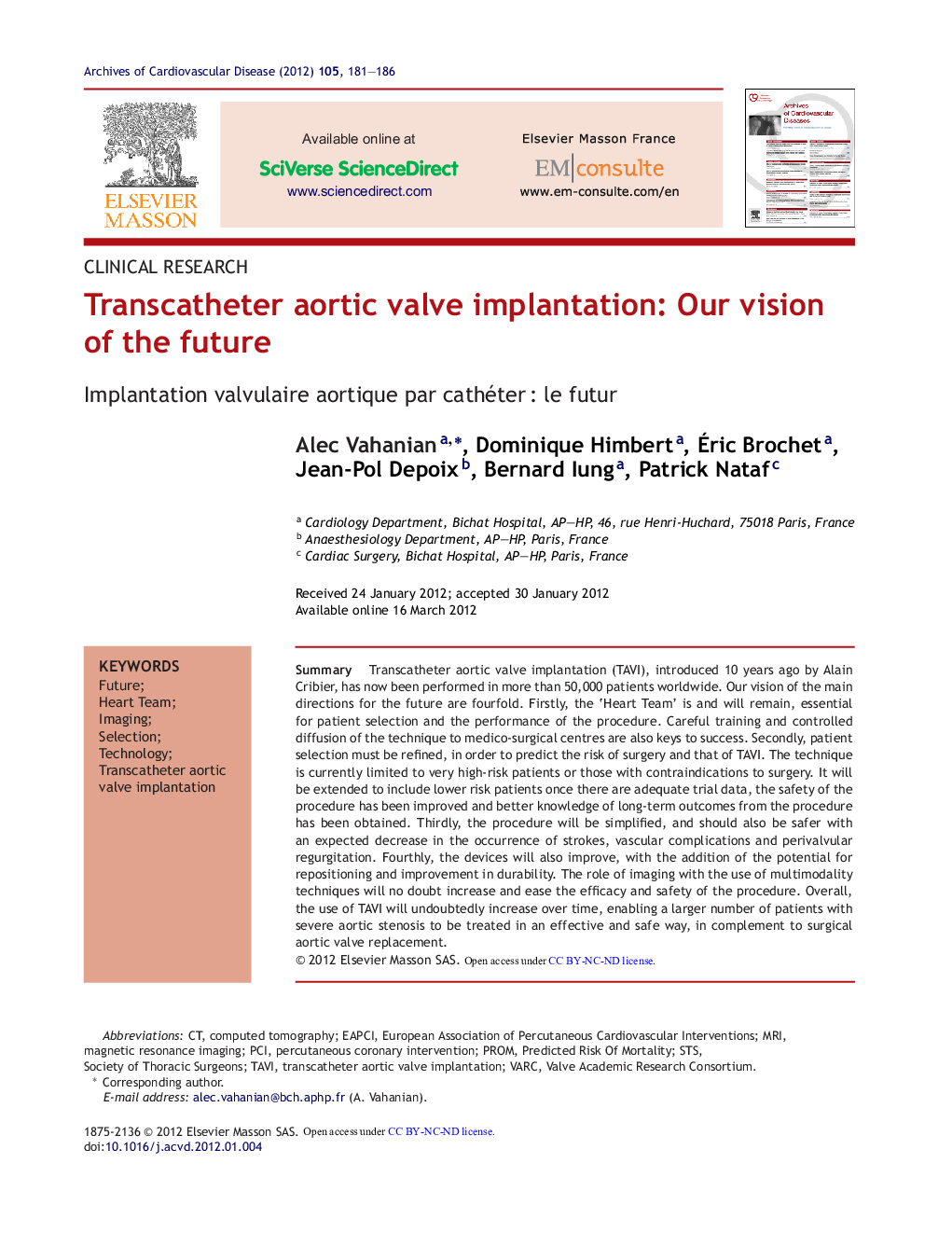| کد مقاله | کد نشریه | سال انتشار | مقاله انگلیسی | نسخه تمام متن |
|---|---|---|---|---|
| 5942449 | 1574376 | 2012 | 6 صفحه PDF | دانلود رایگان |

SummaryTranscatheter aortic valve implantation (TAVI), introduced 10 years ago by Alain Cribier, has now been performed in more than 50,000 patients worldwide. Our vision of the main directions for the future are fourfold. Firstly, the 'Heart Team' is and will remain, essential for patient selection and the performance of the procedure. Careful training and controlled diffusion of the technique to medico-surgical centres are also keys to success. Secondly, patient selection must be refined, in order to predict the risk of surgery and that of TAVI. The technique is currently limited to very high-risk patients or those with contraindications to surgery. It will be extended to include lower risk patients once there are adequate trial data, the safety of the procedure has been improved and better knowledge of long-term outcomes from the procedure has been obtained. Thirdly, the procedure will be simplified, and should also be safer with an expected decrease in the occurrence of strokes, vascular complications and perivalvular regurgitation. Fourthly, the devices will also improve, with the addition of the potential for repositioning and improvement in durability. The role of imaging with the use of multimodality techniques will no doubt increase and ease the efficacy and safety of the procedure. Overall, the use of TAVI will undoubtedly increase over time, enabling a larger number of patients with severe aortic stenosis to be treated in an effective and safe way, in complement to surgical aortic valve replacement.
RésuméL'implantation valvulaire aortique par cathéter (TAVI), qui a été introduite par Alain Cribier il y a dix ans, a été réalisée chez plus de 50 000 patients dans le monde. Les principales directions dans le futur pourraient être les suivantes : la « Heart Team » est et restera essentielle pour la sélection des patients et la réalisation de la procédure. L'entraînement soigneux et la diffusion contrôlée de la technique à des centres médicochirurgicaux sont aussi des clés du succès ; la sélection des patients doit être améliorée, tant en ce qui concerne la prédiction du risque chirurgical que celui du TAVI. Actuellement, la technique est limitée aux patients à très haut risque et à ceux ayant une contre-indication à la chirurgie. Elle sera étendue à des patients à plus faible risque après la réalisation des essais adéquats, lorsque la sécurité de la procédure sera améliorée et son évolution à long terme mieux connue ; la procédure va se simplifier et devrait devenir plus sûre, avec une probable diminution du risque d'accident vasculaire cérébral, de complication vasculaire et de fuite péri-valvulaire ; les dispositifs s'amélioreront aussi grâce à la capacité de repositionnement et à la prolongation de leur durabilité. Avec l'utilisation de techniques multimodales, le rôle de l'imagerie augmentera certainement la simplicité et la sécurité de la procédure. Globalement, avec le temps, l'utilisation du TAVI va croître sans aucun doute, permettant à un plus grand nombre de patients porteurs d'un rétrécissement aortique sévère d'être traités de façon efficace et sûre, en complément de la chirurgie de remplacement valvulaire aortique.
Journal: Archives of Cardiovascular Diseases - Volume 105, Issue 3, March 2012, Pages 181-186